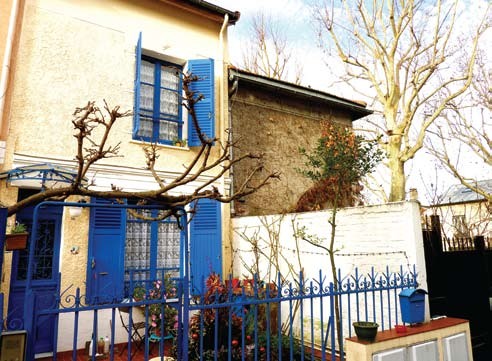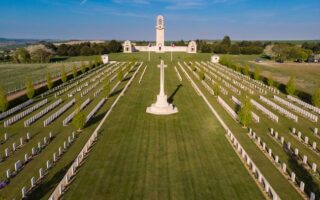Surprising Mouzaïa

Nestled on a gentle slope between the Buttes Chaumont park and the Square de la Butte du Chapeau Rouge, the Quartier Mouzaïa is a warren of villas—and in this case the word means narrow, cobblestoned and tree-lined alleyways or cul-de-sacs lined with candycolored, individual maisonnettes. The picturesque pocket of northeastern Paris remains largely undiscovered by tourists, and by many Parisians as well. The small streets tumble downhill in almost symmetric formation from the rue de Bellevue and stop just beyond the rue Miguel Hidalgo. The houses cling to each other, some with bold, cheerful facades, others more discreet, partially hidden behind neat hedges, climbing ivy or wild, untamed gardens. The early days of spring bring fragrant roses, wisteria, lilac and honeysuckle—scenes of a rural village, a rare reserve of calm. From the Middle Ages until the 1860s, the area served as an enormous open-air gypsum quarry known as the Carrières d’Amérique; the gypsum was made into plaster of Paris, used in the construction of many city buildings. Supplies eventually dwindled, excavation ceased and authorities mulled over what to do with the land, described then as a “haunt for hobos and prowlers”. After attempts to establish a horse market failed, and in efforts to eradicate the wretched poverty of Paris’s outer villages, the city began plans for a subdivision of modest homes to house local workers.
The first houses appeared between 1889 and 1892: a few dozen red brick cottages, almost identical, overseen by architect Paul- Casimir Fouquiau. The unstable nature of the ground dictated certain rules for their construction: no higher than two stories, built according to one of four standard plans that included small gardens in the front and courtyards in back. Over the years, other building materials were used, facades were plastered and painted in sorbet shades and wrought iron gates were given bright makeovers. Today’s residents may have added personal touches by way of whimsical trimmings, but the cobblestones and street lamps remain.
Mosaics and trompe-l’oeil
“We must protect this neighborhood—there is nowhere else in Paris like it,” says Colette Bourdache, Mouzaïa resident for more than 40 years and president of the Syndicat des Intérêts Généraux des Villas du Quartier d’Amérique, the community association. Despite its status as a picturesque site, granted by the Ministry of Culture in 1975, Mouzaïa rarely appears in guidebooks. “I’m often congratulated for living in such a beautiful neighborhood,” says Bourdache. “It’s unique because it’s the largest of its kind— there are 400 houses here,” she says, “and we have more green space than other neighborhoods. Houses are rare in Paris, and even fewer have gardens.” Rumors that the area was dubbed Amérique because the gypsum plaster was used for the Statue of Liberty and the White House are simply “not true”, says Bourdache. “There is evidence that the area was known as Amérique as early as the 17th century,” she says. It’s now usually called Mouzaïa—the name of one main street, commemorating a colonial battleground in Algeria.
The first houses built were in the villas closest to the rue de Bellevue, which separates them from the grim social-housing towers of the Place des Fêtes (“a disaster!” says Bourdache). The most colorful facades are found in the Villa de Bellevue and the Villa des Lilas, while the original 19th-century brick exteriors and mosaics are clearly visible in the Villa Emile Loubet. On the leafy rue de Mouzaïa, the canary yellow and wintergreen house at No. 42 has a quirky trompe l’oeil window. Farther west the Saint François d’Assise church has a big Byzantine-style mosaic surrounded by painted murals. A few doors down, Chez Kim is a local favorite for its authentic and reasonably priced Vietnamese cuisine.
Cafés and hipster hangouts
Although there is a smattering of shops, Bourdache laments the lack of the vibrant community atmosphere created by local businesses. “It’s a real shame,” she says. “The butcher, the grocer, the tailor—they all disappeared after World War II.” Nostalgic for the movie theaters that once animated the neighborhood, Bourdache says that after the arrival of television, they too disappeared. Today the Quartier Mouzaïa is largely residential, home to a mélange of old timers and bobos. As Bourdache remembers it, waves of nouveaux riches residents began arriving in the early 1990s, when property prices skyrocketed and local artisans moved out. “One, a lawyer, has an elevator, in his two-story house”, she chuckles. “Another one claims to have the same landscape gardener as Carla Bruni-Sarkozy!” But while artisans and shopkeepers have moved on, the charming houses remain.
On rue de la Liberté, No. 6 stands out for its millstone exterior, mauve wrought iron trim and Art Nouveau doorway. Steps away, theRenaissance are easily visible—the overgrown gardens of older villas are absent here. On the Place Rhin et Danube, the brasserie Le Danube is popular for its bargain plat du jour and delicious homemade pizzas. The Café Parisien is tucked into one of the oldest buildings, but its original brick-and-beam exterior remains in good shape; on summer days residents compete for a prime spot on the terrace. Remnants of the gates on either end of Villa d’Hauterive, between the rues Général Brunet and Miguel Hidalgo, are reminders of the days, prior to 1959, when the villas were private—note the handsome cornflower- blue house at 13 rue Miguel Hidalgo. The street’s northern offshoots—Villas Rimbaud, Paul Verlaine, Jules Laforgue and Claude Monet—claim the most modern houses, although No. 7 Villa Paul Verlaine is worth a look for its dark, brooding, almost medieval style.
One of the grandest brick houses, flanked by lush hedges, stands at the corner of Villa Marceau and the rue du Général Brunet, not far from La Table de Botzaris, which serves sophisticated (and pricey) French cuisine—a cozy retreat for a romantic tête-à-tête well off the beaten path. At the end of the block sits the marvelous Buttes Chaumont park, where Parisians from farther afield come to stroll, jog, picnic or lounge in the beer garden at the hipster hangout Rosa Bonheur. Commissioned by Napoleon III and designed by civic engineer Jean-Charles Alphand in the 1860s, the park’s steep slopes and uneven terrain are testament to its past life as a gypsum quarry. Wild and rugged, the park boasts cliffs, caves, streams and waterfalls, many of them man-made.
Originally published in the February 2013 issue of France Today
Share to: Facebook Twitter LinkedIn Email
Leave a reply
Your email address will not be published. Required fields are marked *



